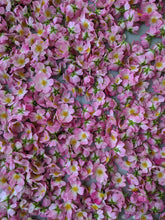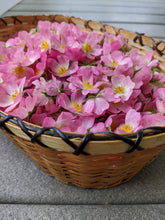
Kunja ☽•☾ Himalayan Musk Rose Soliflore. Single note Rosa brunonii perfume with musk rose enfleurage.
a l c h e m y ☽•☾
The aroma of wild Himalayan Musk Rose created with my Rosa moschata enfleurage, and supported by in house organic extracts of Angolan amber, muskdana, kalonji, kuṣṭha, and muskrat root. Kunja is a solid botanical perfume.
n o t e s ☽•☾
Wild musk rose Rosa brunonii.
Photos: musk roses in my garden of old roses; musk rose enfleurage; enfleurage in 5ml and 10ml black violet glass jars.
Organic Musk Rose Enfleurage ☽•☾
Musk Rose Enfleurage is a solid perfume made by the simple but labor intensive process of cold enfleurage. The only ingredients are fresh, musk rose flowers grown in my organic garden, avocado butter, and very raw beeswax. It is organic and handmade. The scent is true to the Rosa moschata species: dry, saline, with a back note of ambrette seed musk. To my nose, its aroma is redolent of white wines from the Languedoc region, with a dry, tangy, and briny profile like sun-baked sand bearing the impression of dried sea foam. Rosa moschata's origins are unknown, but it probably grew wild in the western Himalayas during ancient times. It had been imported to western Europe by at least the end of the sixteenth century, as the musk rose is mentioned in A Midsummer Night's Dream.
In my opinion, enfleurage is the best process to capture all of the aromatic nuances of a flower in bloom. This "pommade" (highly scented solid perfume-- not to be confused with pomade for hair) consists of thousands of individual organic musk rose flowers that I gathered from my perfume gardens, laid onto an emulsion of organic avocado butter and raw beeswax. Daily, I clean the enfleurage and repeat the process to reach a degree of fragrance saturation. In my enfleurage, the Rosa moschata scent is salty, with a hint of ambrette. Buyer beware: true to the flower, its perfume is extremely delicate. It is very much the opposite of the shrill, overpowering version of a synthetic rose you find at the fragrance counter. Only you and those closest to you will be able to smell it. Apply to well hydrated skin without rubbing in.
PLEASE READ:
**Although the floral perfume produced by enfleurage is osmically balanced (meaning it contains sufficiently complex interplay of top through base notes to be considered a perfume in itself), it is a subtle creation. It must be given time to breathe on the skin. When cold, it may not smell much at all. Allow it to breathe and warm on a pulse point before inhaling deeply. Most noses love the aroma of my enfleurage but, a small percent of my clients are anosmic to enfleurage and therefore cannot smell the floral fragrance. This has to do with natural differences in nasal receptors and is not due to an issue with the product. I always recommend ordering a sample before committing to a larger size for this reason.**
A B O U T • W I L D • V E I L • E N F L E U R A G E
Enfleurage is a beautiful process whereby odorless fats that are solid at room temperature are used to capture the fragrant compounds exuded by plants. Enfleurage is by far one of the oldest methods of fragrance extraction, and it is nearly extinct. Only a handful of artisans still practice it today as it is no longer used in the manufacture of perfumes on a mass scale. A voluptuous art, enfleurage is quite the labor of love, consuming time, labor, and expense. Historically enfleurage was done by women, or maidens, in the fields of Grasse, France. Although far rarer to find enfleurage products in the market today, it is still largely practiced by women.
There are two types of enfleurage: "cold" and "hot." Wild Veil exclusively uses cold enfleurage:
In cold enfleurage, a large framed plate of glass, called a chassis, is smeared with a layer of fat, traditionally unscented animal fat rendered from lard or tallow, and allowed to set. Wild Veil does not use any animal fat whatsoever! My enfleurage products are organic and botanical; I choose fats from a variety of nut and plant butters such as shea, jojoba, avocado, fair trade palm, and mango. Botanical matter, usually petals or whole flowers, is then placed on the fat and its scent is allowed to diffuse into the fat over the course of 1-3 days. The process is then repeated (up to 36 times depending on the fat and the botanical matter) by replacing the spent botanicals with fresh ones until the fat has reached a desired degree of fragrance saturation. The cold fat process was developed in southern France in the 18th century for the production of high-grade concentrates.
In hot enfleurage, solid fats are heated and botanical matter is stirred into the fat. Spent botanicals are repeatedly strained from the fat and replaced with fresh material until the fat is saturated with fragrance. This method is considered the oldest known procedure for preserving plant fragrance substances. So far Wild Veil only incorporates cold enfleurage into products.
In both instances, once the fat is saturated with fragrance, it is then called the "enfleurage pommade." This is a highly perfumed solid fat, not to be confused with pomade used for styling hair. Historically, this enfleurage pommade was either sold as it was,* or it could be further washed or soaked in ethyl alcohol to draw the fragrant molecules into the alcohol. When the alcohol was separated from the fat and allowed to evaporate, it would leave behind the absolute of the botanical matter. The spent fat would typically be used to make soaps since it is still fairly fragrant. *This listing is for an organic pommade.
The advent of modern perfumery ushered in the ease and relative inexpense of commercial solvent-based extraction of natural materials along with mass production of synthetic compounds, making the art of enfleurage seem highly inefficient and costly in comparison. The method is now superseded by more efficient techniques such as solvent extraction or supercritical fluid extraction using liquid carbon dioxide (CO2) or similar compressed gases. Enfleurage had been the sole method of extracting the fragrant compounds (containing thousands of aromachemicals) from delicate floral botanical such as jasmine and tuberose, which are be destroyed or denatured by the high temperatures required by cheaper methods of fragrance extraction such as steam distillation. It is still believed by some perfumers that enfleurage remains the only way to capture and preserve the full range of complexity of certain scents, particularly of flowers.
s i z i n g ☽•☾
I offer enfleurage in sizes of 1ml (a sample of approximately 20-25 drops, or one fifth of a teaspoon), 5ml and 10ml. 1ml (sample size) comes in a hinge top pod. 5ml comes in a glass jar. 10ml is available in a glass jar or a round tin.
Please make your selection from the menu.
r a w ☽•☾ m a t t e r
Wild Veil natural perfumes are composed by me, Abby, using homemade, wildcrafted and organic aromatics in Vermont. These include my handmade enfleurage, tinctures, enfleurage extraits, absolutes, resinoids and concretes, and floral waxes. I spend as much time growing plants and foraging as I do composing perfumes.
h o w ☽•☾ t o ☽•☾ w e a r
The best way to experience a natural perfume is to apply it to well-moisturized skin, without rubbing in (absorption only shortens the wear time of fragrance) and without scrubbing off. Natural perfumes are dynamic and take a minimum of 2 hours to reach their final stage, or dry down. Enjoy the alchemical changes as they unfold from the initial intensity of top notes, to the warmth of the heart, to the depth of lower base notes.
☽•☾ Wild Veil ☽•☾ alchemy between earth and ether ☽•☾
☽•☾ All aesthetic material copyright Abby Hinsman 2022 ☽•☾




































